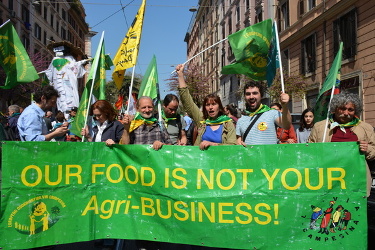Corporate food system currently contributes between 44 and 57% of global greenhouse emissions

As never before, agriculture today plays a role in all of the unfolding crises of the twenty-first century. Despite producing many more calories than are needed to feed humanity, the globalized food system leaves a billion people hungry, and another billion with micronutrient deficiency (Kremen, Iles and Bacon, 2012).
At the same time, the growing dependence on chemical fertilizers and pesticides, as well as petroleum, coupled with oversized feedlots and global commodity routes, make the planet’s food system among the chief factors contributing to carbon dioxide and methane emissions causing global climate change (Tilman et al. 2001).
The modernization of global agriculture has meant the application of technologies that maximize short-term yields at the same time as they undermine the long-term factors of agricultural productivity and stability, such as soil fertility, water cycles, seed diversity and local knowledge.
The science and technology used to produce food is generally owned by large transnational corporations that are guided by the profit motive, rather than any of the many other purposes that agriculture serves, such as providing food and health, guaranteeing sustainable livelihoods, or maintaining a natural resource base for future generations.
The industrial agriculture model is only about 60 years old, but has already contaminated water sources, replaced tens of thousands of seed varieties with a dozen cash crops, diminished soil fertility around the world, accelerated the exodus of rural communities toward unsustainable megacities, and contributed to global inequality. Additionally, the corporate food system currently contributes between 44 and 57% of global greenhouse emissions (Grain, 2011).
For a long time, corporate manufacturers have insisted that pesticides are safe to use, that expensive, hybrid seeds will produce better in all field conditions, and that the same technical packages can be applied to diverse agricultural systems (Ecobichon, 2001). Research has conclusively shown not only that these are myths, but that the same consolidated seed and chemical companies that now control our access to food have been dishonest all along about their knowledge of harm produced by their products (UN Special Rapporteur on the Right to Food,2017).
Pesticides, synthetic fertilizers, and petroleum-hungry monoculture are responsible for hundreds of thousands of annual deaths of farmers and farm workers by poisoning, as well as incalculable damage to ecosystems, watersheds and the atmosphere. Additionally, the technologies of industrial monoculture diminish the capacity of agriculture to employ the rural workforce, leading to abandonment of the countryside and the loss of the cultural diversity embedded in rural communities.
La Vía Campesina, the world’s largest peasant movement, is a leading voice in the global movement to recover food from transnational corporations. Since its first international conference in Tlaxcala, Mexico, in 1996, La Vía Campesina (LVC) has proposed food sovereignty as an alternative to corporate agribusiness (see Box 1). Food sovereignty can be briefly defined as the right of peoples and nations to create and maintain their own food systems, and has been at the heart of civil society protests against the free trade model since the 1990s. Food sovereignty means a fundamental emphasis on local and domestic food production, based on land access for small farmers and ecological production practices (Rosset, 2006). As a political proposal, food sovereignty implies a radical democratization and decentralization of the agriculture-food system, including the dismantling of corporate power over food (Patel, 2009). On a more cultural level, it is an affirmation of rural community, local knowledge, and gender equality (Wittman, 2010). Rather than the better-known concept of food security, which makes no mention of where food comes from or how it is produced, food sovereignty explicitly underscores local and national food routes, democratic processes of decision-making, recuperation of cultural forms of production, distribution and consumption, and the relationship between food and the environment.
This article is an excerpt from a toolkit published by La Via Campesina that explores the Peasant Agroecology Schools and the Peasant-to-Peasant Method of Horizontal Learning. For more about the toolkit, click here
